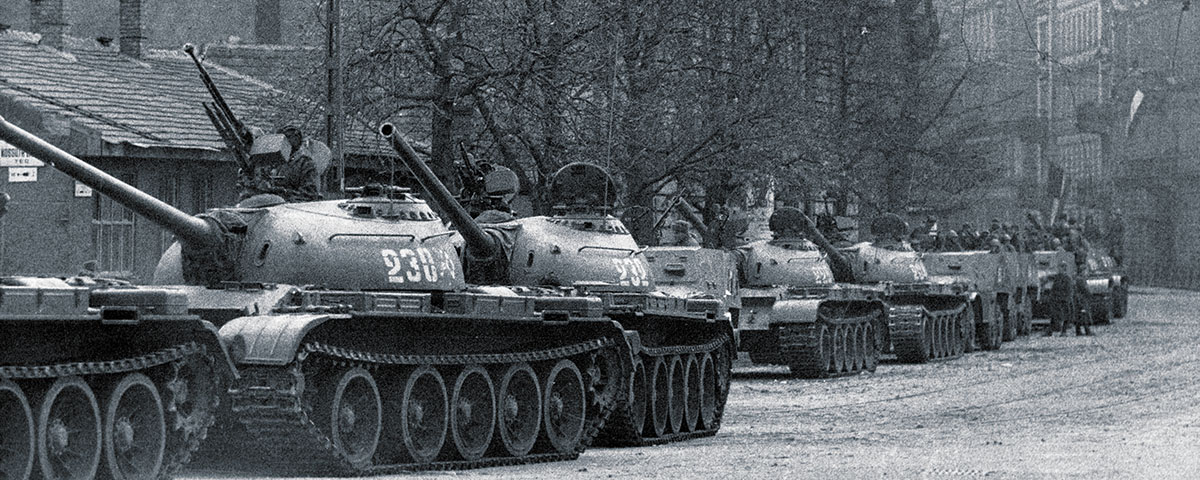On the evening of Oct. 23, 1956, rapidly escalating political tensions in Budapest, the capital of Soviet-occupied Hungary, touched off like a powder keg outside the Radio Budapest building. A delegation of pro-reform demonstrators had gone to the station to broadcast to the nation its demands for free elections and the immediate removal of Soviet troops. The Hungarian people had suffered years of brutal repression under Soviet-backed dictator Mátyás Rákosi, his purges having claimed tens of thousands of Hungarian officials and intellectuals. Moscow’s recent removal of Rákosi from power, as well as a spreading reform movement in Poland, led many Hungarian students and workers to believe liberalization and freedom was finally within their grasp. Cheered on by tens of thousands of protesters, men with tow cables and blowtorches pulled down a statue of the loathed Joseph Stalin looming over the central park. Others toppled red stars from various communist buildings and monuments. In their place Hungarian tricolor flags—the central Soviet coat of arms crudely cut out—rose over a city ripe for rebellion.
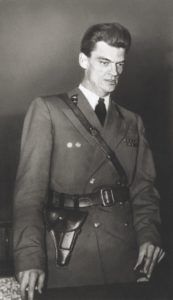
Communist officials had activated Hungarian army units to quell the street demonstrations, but guarding the headquarters of Radio Budapest were officers of the AVH, the secret police, which had no intention of turning over the airwaves to dissenters. As the reformist delegation entered the building, the secret police detained them. That only drew more protesters, which the AVH tried in vain to disperse with tear gas. When the growing crowd moved to force its way into the building, the AVH—dogmatic, well armed and cornered like rats—opened fire, wounding several protesters and killing an army officer who’d been trying to defuse the standoff. An ambulance soon arrived, its nervous driver insisting he had orders to tend to wounded inside the building. Suspicious protesters threw open the vehicle doors, only to discover a cache of arms intended to resupply the besieged AVH officers. Enraged, the crowd tore the driver to pieces. His death gave protesters their first weapons and the resolve there was no going back.
The spark at Radio Budapest ignited a revolutionary fervor citywide. Demonstrators raided military arsenals for weapons, and arms factory workers brought more. Many Hungarian soldiers tore the red stars from their uniform caps and joined the uprising. As the unrest spread, Colonel Pál Maléter, the highest-ranking officer to change sides, assumed a de facto leadership role. After moving civilians and defectors within the massive stone walls of the Kilian Barracks, Maléter awaited the Soviet reaction he knew would come fast and hard.
As word of the uprising reached Moscow, it became clear the limited number of Soviet troops on hand would not be able to deal with the massive unrest. That night five divisions, comprising some 31,500 troops and 1,130 tanks and self-propelled guns, were put on alert and ordered into Budapest. The Soviet army had recently equipped several of the divisions with the latest version of its advanced T-54 tank. A product of lessons the Soviets had learned battling superb German armor during World War II, the T-54A included technical innovations covertly copied from U.S. tanks captured by communist Chinese forces during the Korean War. Lighter, better armored and harder hitting than any tank the West had at the time, the T-54A was about to make its combat debut.
Perhaps it was just a fortunate coincidence, but as the Soviet Union rolled its battle tanks toward Budapest, Britain had a knowledgeable and experienced tank man on scene. Lieutenant Colonel James Noel Cowley, the military attaché recently assigned to the British Embassy in Budapest, was watching with growing interest the events unfolding in the city. Cowley was a far cry from the typical administrative soldier in diplomatic postings. In the British army since 1931, Cowley had led a squadron of Sherman tanks ashore at Normandy on D-Day. Four days later he’d received a near-fatal head wound. Hospitalized for several months, he was eventually declared medically unfit for combat service. On recovery he’d performed occupation duty in Germany, after which he’d been handed the seemingly benign posting in Hungary.
Cowley soon demonstrated that whatever his instructions from London actually were, he would not be playing the part of a paper-pushing diplomatic functionary. On the evening of October 23, when word of the clash at the radio station reached him, Cowley had been attending a dinner function in full dress uniform. He calmly returned home, changed clothes, collected a pistol and disappeared into the Budapest night.
As the sun rose the next morning on the beleaguered city, Cowley reappeared at the embassy (likely worse for wear after his nocturnal sojourn) and watched with interest as a column of T-54s ground its way into Budapest. At his side was László Regéczy-Nagy, a young and resourceful Hungarian who worked as an embassy driver. Regéczy-Nagy had been a tanker in the Royal Hungarian Army before being captured by the British in 1945, and the opportunity presenting itself, even in the midst of crisis, was certainly not lost on him. As he recently reflected, “Sixty years ago Colonel Cowley must have been the only NATO officer who could put hands on such Soviet secrets.” Cowley would not let such a golden opportunity pass him by, and Regéczy-Nagy proved an able accomplice.
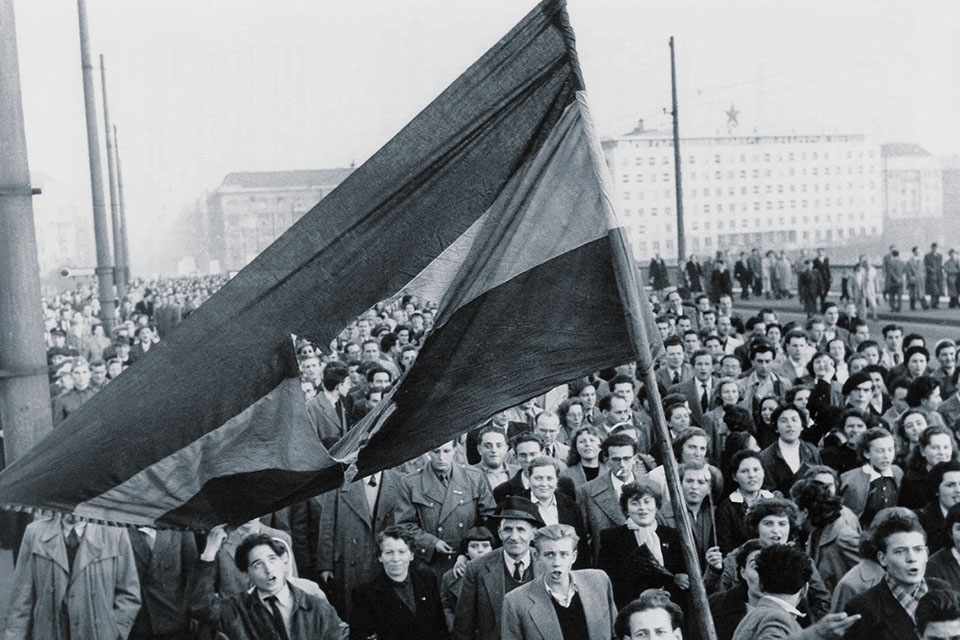
The Red Army that had crushed Berlin so effectively in 1945 seemed to have forgotten even the most basic rules of urban combat. Tall buildings lining narrow streets proved ideal fighting positions for Hungarian revolutionaries—and death traps for the Soviet armored vehicles below. Though perhaps the best main battle tank in the world at the time, the T-54A suffered the same Achilles’ heel as all unsupported armor caught on tight streets in a hostile city. The Hungarian fighters—despite their tender age, dearth of anti-tank weapons and lack of combat experience—nevertheless took a heavy toll on the Russian tanks.
By hanging saucepans from telephone wires, which looked worryingly like anti-tank mines to a Soviet tanker viewing the world through a narrow vision port, the Hungarians were able to divert and corral the T-54s on narrow side streets pre-slicked with oil or grease. Spinning their tracks uselessly with no room to maneuver, the tanks were left vulnerable to bombardment with Molotov cocktails crafted from lemonade bottles and pilfered petrol. The bold Hungarian fighters dashed from cover and aimed for auxiliary fuel tanks on the T-54s’ rear hulls—helpfully labeled gasoline in Russian. Many insurgents laid down their lives in such near-suicidal attacks, but the increasingly common sight of burned-out T-54s clogging Budapest roads proved the hard cost was worth the gain.
On October 25 several thousand unarmed civilians, including women and children, gathered outside the Hungarian parliament to protest the Soviet invasion. Enraged by their recent losses, the invaders were in no mood to tolerate even a nonviolent demonstration and opened fire on the crowd with machine guns, killing scores of civilians. While the AVH took initial blame, Cowley had witnessed the event firsthand and later claimed “Russian tanks took the larger part” in the massacre. The colonel estimated the number of casualties at around 600. “The horror and carnage of the scene,” he recalled, “would appall the most hardened of imaginations.” If the violence hadn’t been personal before, it was now.
Driving around the war-torn city in his embassy-issued Land Rover, Regéczy-Nagy realized the Soviet T-54s, which till recently had been a closely guarded military secret, were available for inspection to any individual bold enough to try. Hungarian rebels had helpfully immobilized several examples. Passing the Kilian Barracks—the site of what came to be known as the Battle of the Corvin Passage—Regéczy-Nagy spotted two such knocked-out T-54s. “I at once stepped on the accelerator to report the finding to the colonel,” he recalled. Amid the devolving urban combat Regéczy-Nagy and Cowley each continued to patrol, observe and report. At one point the colonel wound up trapped between a Hungarian defensive position and a Soviet flanking attack. Engaging in a dangerous game of cat and mouse with Soviet armor through a maze of side streets, he managed to get away.
After a week of fighting and severe casualties on both sides, the Soviets had little to show for their efforts but rubble and blood. “They had counted on their presence, accompanied by some threatening bursts of machine-gun fire, frightening the population into a submission of their exuberance,” Cowley observed. “Nothing could have been further from reality; the intervention of the Russians only seemed to make the people more angry and more determined to pursue the fight.” Like some of their counterparts in the Hungarian forces, Soviet soldiers—appalled at the sight of suffering innocents—lost the will to fight. There were even reports of rogue Soviet tankers turning their guns on AVH policemen as the latter fired on civilians.
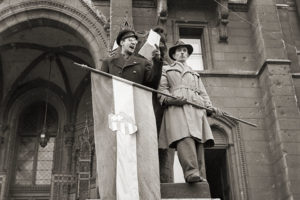
On October 28 the interim Hungarian government led by communist reformer Imre Nagy announced a cease-fire, and battered Soviet units began withdrawing from Budapest. Meanwhile, Nagy ordered the dissolution of the AVH and declared a general amnesty for the insurgents.
The November 2 edition of the Hungarian army newspaper reported on a meeting between Maléter—erstwhile defector and Hungary’s newly minted Minister of Defense—and “a thin and tall colonel who was the military attaché of the United Kingdom.” During their meeting Colonel Cowley congratulated Maléter on his determined defense of the Kilian Barracks and offered military advice on how to “hold on to the results achieved.” In exchange for Cowley’s sage counsel, and perhaps in hopes of obtaining British support for Hungarian independence, Maléter in turn shared intelligence regarding the strength and movements of Soviet units. According to Maléter aide Péter Gosztonyi, the defense minister also granted Cowley permission to inspect a captured T-54A. Maléter himself later boasted to associates his cooperation with Cowley had been “complete.”
For their part, the Soviets later claimed Cowley had “taken part in the direction of the counterrevolution.” They cited supposed eyewitnesses who’d watched as agents in cars with license plates from “foreign capitalist countries” distributed British- and American-made weaponry to rebels. Whatever covert deals Maléter and Cowley may have been struck remain shrouded in the still-classified nature of Cold War clandestine activity. We do know that at some point the captured T-54A did make its way inside the British Embassy compound. Before dutifully returning it to the Soviets, the British pored over the tank. Their findings were troubling, to say the least. Though smaller than its Western counterparts the British Centurion and American M48 Patton, the T-54A’s armor could defeat the penetrative power of both the British 20-pounder and American 90 mm tank guns, essentially rendering both obsolete.
While Cowley was covertly tinkering with his armored windfall, the situation in Hungary took an ominous turn. On November 1, in response to reports of continued Soviet troop movements into Hungarian territory, an enraged Nagy informed Moscow that Budapest was withdrawing from the Warsaw Pact, effective immediately. While the Soviets might have tolerated moderate reform, they would not accept Hungary’s secession from their sphere of influence. Their reaction was swift and overpowering.
To mislead and distract the Hungarian government, Moscow initiated talks concerning the wholesale withdrawal of Soviet forces. On November 3 Maléter, invited to Red Army headquarters ostensibly to open negotiations, was instead promptly arrested. All the while the Soviets were preparing 17 divisions and massing some 60,000 men for the aptly named Operation Whirlwind.
Cowley was asleep early on the morning of November 4 when explosions shattered the calm. Advancing rapidly in force, the Soviets encircled Budapest and opened fire with artillery and large-caliber mortars. Some 2,500 Soviet tanks then split the city down the middle and fanned out, quickly seizing government buildings and key strategic positions.
Though sympathetic to the plight of the Hungarians, the British government was unwilling to risk turning the Cold War hot, especially given its controversial participation in the ongoing Suez Crisis, sparked by Egyptian President Gamal Abdel Nasser’s unilateral decision to nationalize the canal. The Crown’s reticence left Cowley and the rest of the British legation in a difficult position. Hungarian fighters choked the embassy switchboard with desperate calls for assistance. One resistance leader, about to be overrun by Soviet tanks, shouted into Cowley’s receiver, “For God’s sake, do something to save Hungary!” Nothing would be done. The fighting spread to the very perimeter of the embassy, shattering assurances of diplomatic immunity and leaving embassy staffers with little option than to hug the floor or hunker in the cellar and wait for the storm to pass.
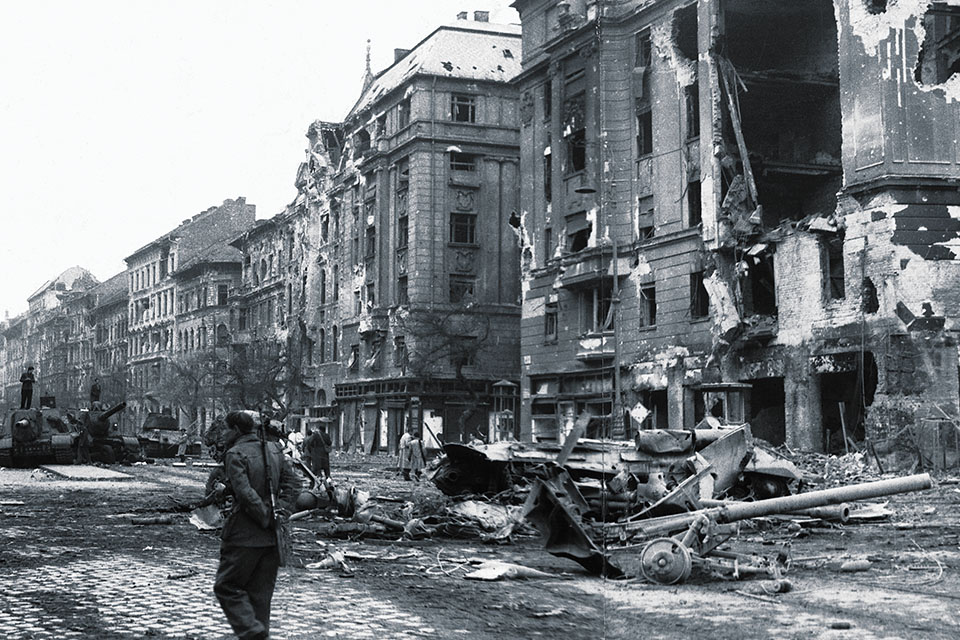
In short order the Soviets brutally subdued the main pockets of resistance and installed a new puppet government. Reprisals were widespread and harsh. Communist officials tried both Nagy and Maléter as conspirators, executing them and ultimately killing, imprisoning or forcing into exile many thousands of others for their roles in the revolution. Sentenced to 15 years in prison, Regéczy-Nagy was released early in 1963.
In January 1957 the puppet government got around to Colonel Cowley. Citing among other transgressions “intensive intelligence-gathering about Russian tanks and equipment,” it declared him persona non grata and ordered him out of Hungary within 48 hours. Though the British government responded with a strongly worded rebuttal, Cowley was expelled. As part of that year’s Queen’s Birthday Honours, Elizabeth II awarded him the Order of the British Empire.
Perhaps tellingly, the recommendation for the colonel’s award initiated with Brigadier Charles H. Tarver, the deputy director of British military intelligence and a man for whom Cowley had never officially worked. In the OBE citation Tarver commended Cowley for being “indefatigable in pursuit of information,” noting that “he ran risks which a less conscientious officer might have considered unnecessary. He produced excellent results.”
Excellent results, indeed. Engineers at Britain’s newly created Armament Research and Development Establishment used the valuable data Cowley had gleaned from the captured T-54A to create a gun capable of defeating the Soviet tank. By 1959 the British army was fielding a new model Centurion fitted with the fruits of that labor—the Royal Ordnance L7 105 mm main gun. The new American M60 Patton also employed the L7, as would the first generation of its replacement, the M1 Abrams. All told, nearly two-dozen Western tank models were ultimately armed with the L7.
GET HISTORY’S GREATEST TALES—RIGHT IN YOUR INBOX
Subscribe to our HistoryNet Now! newsletter for the best of the past, delivered every Monday and Thursday.
Reliable and versatile, the gun excelled at its designed purpose—cracking open the armor of Soviet-built tanks—as proven on numerous battlefields. A pair of Israeli Centurions (renamed the Sho’t—Hebrew for “whip”) attained legendary status during the 1973 Yom Kippur War when they employed their L7s to destroy more than 60 attacking Syrian T-55s and T-62s in the Battle of the Valley of Tears. On Feb. 27, 1991, during Operation Desert Storm, a battalion of U.S. Marine Corps M60A1s armed with the L7 ravaged a far larger Iraqi armored force near Kuwait International Airport, knocking out 100 tanks and armored personnel carriers, including 50 top-of-the-line Soviet-built T-72s. None of the American tanks were lost to enemy action.
Following his exploits in Budapest, Cowley went on to serve at the British embassy in Tel Aviv, Israel. He retired from military service in 1961 and died in 2010 at age 97, never having publicly acknowledged the role he played in taming the “Beasts of Budapest.”
Nicholas Smith is a U.S. Army Reserve officer and works as a Homeland Security contractor in Northern Virginia. For further reading he recommends The Hungarian Revolution, 1956, by Rupert Colley; T-54 and T-55 Main Battle Tanks, 1944–2004, by Steven J. Zaloga; and As Luck Would Have It: A Memoir, by Sir Leslie Fry.

